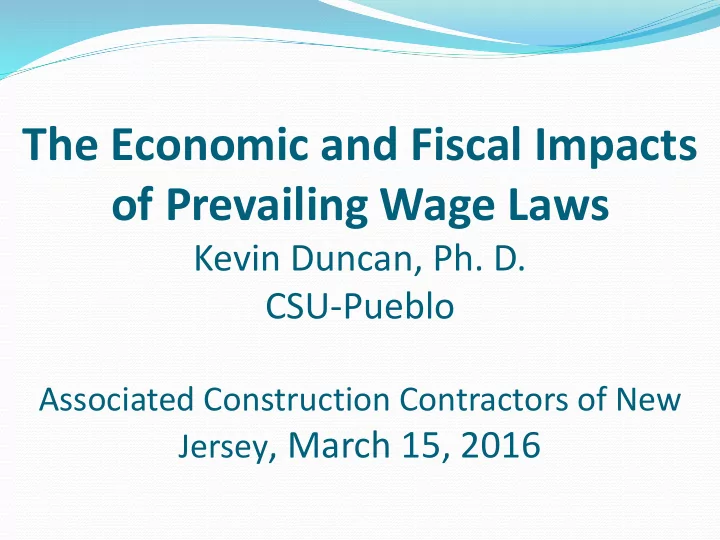

The Economic and Fiscal Impacts of Prevailing Wage Laws Kevin Duncan, Ph. D. CSU-Pueblo Associated Construction Contractors of New Jersey , March 15, 2016
Purpose of Prevailing Wages Main purpose is to protect local wages: Davis-Bacon Act: Large government contracts may attract low wage contractors with competition depressing local wages. Wage floor creates a level playing field allowing all contractors to compete without depressing local wage standards.
Three Consequences of Prevailing Wages that are Important to Research Prevailing wages and construction costs: Peer-reviewed versus other research. Protecting local wages protects local work: An economic impact on the region/state. Impact on apprenticeship training: More training with prevailing wages. Impact of construction worker poverty: Less reliance on public assistance and lower taxpayer burden. Repeal? Cost savings? Lower economic activity, less training, and increased poverty and tax burden.
Research Based on Publicly Available Information U.S. Census Bureau : Economic Census of Construction (2012) Information on value of construction and costs. U.S. Department of Labor : Bureau of Labor Statistics: Current Population Survey (construction worker income and employment status). U.S. Department of Commerce : Bureau of Economic Analysis: Information for economic impact. Research is reproducible.
Research on Prevailing Wages and Construction Costs Difference in results between peer-reviewed research and research without expert review. Purpose of peer-review is to insure quality, credibility, and maintain standards. Peer-reviewed research takes years to complete. Peer-reviewed studies have examined: Federal, state and local polices, Schools, highways, low-income housing, etc.
Peer-Reviewed Research in the Last 15 Years 75% of all research finds no prevailing wage cost effect . 80% for studies on school construction. Colorado highway resurfacing studies as example. CDOT Bid data, 2000-2011. No cost difference between fed and state projects. No difference in bid competition for fed and state projects. No cost difference in fed projects with change from union to average wages. No change in bid competition with union/average wage change. No bid cost difference when contractors switch from fed to state projects.
Why No Prevailing Wage Cost Effect? It’s Counter -Intuitive? Other costs and factors change with wages: Peer-reviewed research: when wages are high, skilled replace unskilled workers and more equipment is used. Economic Census of Construction : high wages & benefits: Lower material, fuel costs and profits. Labor costs are a low percent of total construction costs (23%).
Preponderance of Peer Reviewed Research Suggests: Eliminating prevailing wages does not reduce construction costs. Peer- reviewed research doesn’t stop prevailing wage opponents: It’s intuitive: wages and costs. Claims up to 36% cost savings with repeal. Claims generally supported by low quality, “back -of- the envelope” cost estimates. Low quality studies promise savings with repeal that cannot be delivered.
Economic Impact of Prevailing Wages By protecting local wages, prevailing wage laws protect work for local contractors and construction workers. Supporting evidence from the Economic Census of Construction (2012): States with weak/no prevailing wages: 2.4% more of total construction value completed by out-of-state contractors.
What Would Prevailing Wage Repeal Mean to New Jersey? New Jersey law is considered strong. A change to the typical weak or no law state (2.4%): About $900 million (2012) in additional construction value completed by out-of-state contractors.
New Jersey Construction Value by New Jersey Contractors 91.4% of NJ value is due to NJ contractors. 8.6% completed by out-of-state contractors. National averages: Strong/Average PW law states = 93.2% Weak/No PW law states = 90.8% Value completed in-state depends on PW and state size.
New Jersey Construction Work Completed by Contractors in Nearby States State Value of Work in New Jersey Pennsylvania $2.1 billion (5.5%) New York $840 million (2.2%) Massachusetts $155 million (0.4%) Delaware $100 million (0.3%) Maryland $77 million (0.2%) Source: 2012 Economic Census of Construction
Prevailing Wages and Local Economic Development Prevailing wages reduce the leakage out of the area. More local employment, more local spending. Benefit to industries unrelated to construction. Built-in economic development tool . Local tax dollars to employ local companies and workers.
Economic Impact of Prevailing Wage “Weakening” on the Wisconsin Economy Along with researchers from Smart Cities Prevail and the Illinois Economic Policy Institute, examined impact on: California, Nevada, Wisconsin, Michigan, New Hampshire, and New Mexico. Wisconsin as an illustration: Leakage = $500 million. Leakage Impact = -$1.1 billion, -6,700 jobs, -$41 million in state and local tax revenue.
Impact on Apprenticeship Training Joint labor-management programs are responsible for most training: (Peter Philips, University of Utah). Wisconsin: joint programs = 95% of training expenditures, ABC = 5%. Wisconsin graduates: joint programs = 82%, ABC = 18%. Repeal reduces resources for training and apprenticeships: Approximate 40% decrease in apprenticeships with repeal in Colorado and Kansas. Greater reliance on other states for skilled workers: Adds to the leakage impact.
Prevailing Wages on Construction Worker Poverty Repeal lowers construction worker wages and benefits, increases poverty, dependence on public assistance, and reduces participation in health and retirement benefits. Based on a comparison of states with strong/average prevailing wage laws and states with no/weak laws.
Wisconsin Construction Worker Income and Poverty Status with Weakened Prevailing Wages Category Current Estimate: # Estimate with a of construction weakened /repealed workers prevailing wage Below Poverty 3,800 6,100 (61%) Level income Food Stamps 2,900 5,300 (83%) (SNAP) Earned Income 8,300 9,200 (11%) Tax Credit Health Insurance 56,400 48,700 (-14%) Retirement Plan 29,600 26,600 (-10%) Source: Current Population Survey
Conclusion Prevailing wage repeal proponents typically claim construction cost savings. Peer-reviewed research: Significant savings are unlikely. More leakage and reduced economic activity. Less apprenticeship training overall. Increased construction worker poverty and tax payer burden.
Recommend
More recommend